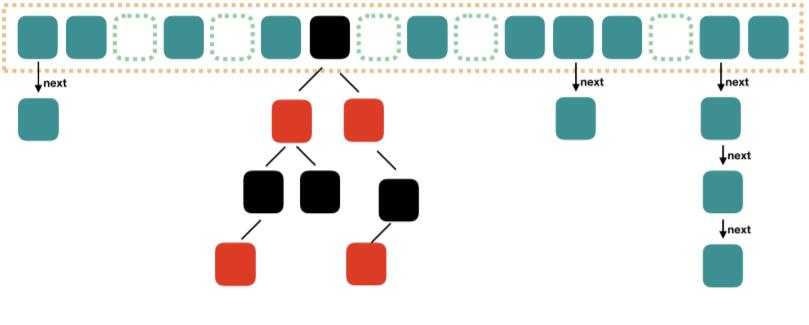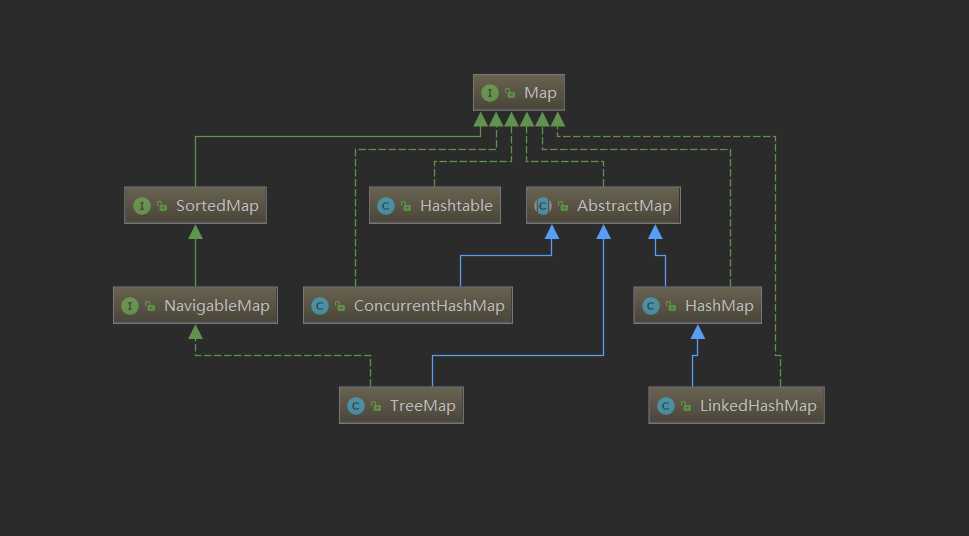标签:资料 dfa 红黑树 most alc 使用 长度 可变 冲突
之前章节复习了Collection接口相关,此次我们来一起回顾一下Map相关
。本文基于jdk1.8。

/**
* The default initial capacity - MUST be a power of two.
*/
// 数组长度默认的容量为16 必须是2的幂
static final int DEFAULT_INITIAL_CAPACITY = 1 << 4; // aka 16
/**
* The maximum capacity, used if a higher value is implicitly specified
* by either of the constructors with arguments.
* MUST be a power of two <= 1<<30.
*/
// 最大容量 为2^30
static final int MAXIMUM_CAPACITY = 1 << 30;
/**
* The load factor used when none specified in constructor.
*/
// 默认的负载因子,当构造时没有指定负载因子时使用此值
static final float DEFAULT_LOAD_FACTOR = 0.75f;
/**
* The bin count threshold for using a tree rather than list for a
* bin. Bins are converted to trees when adding an element to a
* bin with at least this many nodes. The value must be greater
* than 2 and should be at least 8 to mesh with assumptions in
* tree removal about conversion back to plain bins upon
* shrinkage.
*/
// 链表的长度大于8时转换为红黑树
static final int TREEIFY_THRESHOLD = 8;
/**
* The bin count threshold for untreeifying a (split) bin during a
* resize operation. Should be less than TREEIFY_THRESHOLD, and at
* most 6 to mesh with shrinkage detection under removal.
*/
// 链表中的长度小于6时从红黑树转换会链表
static final int UNTREEIFY_THRESHOLD = 6;
/**
* The smallest table capacity for which bins may be treeified.
* (Otherwise the table is resized if too many nodes in a bin.)
* Should be at least 4 * TREEIFY_THRESHOLD to avoid conflicts
* between resizing and treeification thresholds.
*/
// 链表转换为红黑树也不是随便转换的,需要满足Map中最少有MIN_TREEIFY_CAPACITY个Node才能允许树形化(将链表转化为红黑树)。
// 否则表中的过多节点会选择扩容
// 为了避免扩容和树形化的冲突的选择冲突,此值最少为 4 * TREEIFY_THRESHOLD
// 数组长度小于64也不会将链表转为红黑树(链表长度大于8但是小于64选择扩容数组,重新hash)
static final int MIN_TREEIFY_CAPACITY = 64;
/**
* The table, initialized on first use, and resized as
* necessary. When allocated, length is always a power of two.
* (We also tolerate length zero in some operations to allow
* bootstrapping mechanics that are currently not needed.)
*/
//
transient Node<K,V>[] table;
/**
* Holds cached entrySet(). Note that AbstractMap fields are used
* for keySet() and values().
*/
transient Set<Map.Entry<K,V>> entrySet;
/**
* The number of key-value mappings contained in this map.
*/
// Map中键值对的数量
transient int size;
/**
* The number of times this HashMap has been structurally modified
* Structural modifications are those that change the number of mappings in
* the HashMap or otherwise modify its internal structure (e.g.,
* rehash). This field is used to make iterators on Collection-views of
* the HashMap fail-fast. (See ConcurrentModificationException).
*/
// 修改次数
transient int modCount;
/**
* The next size value at which to resize (capacity * load factor).
*
* @serial
*/
// (The javadoc description is true upon serialization.
// Additionally, if the table array has not been allocated, this
// field holds the initial array capacity, or zero signifying
// DEFAULT_INITIAL_CAPACITY.)
// 下一次扩容的阈值 Map数组长度 * 负载因子
int threshold;
/**
* The load factor for the hash table.
*
* @serial
*/
// 负载因子
final float loadFactor;/**
* Constructs an empty <tt>HashMap</tt> with the specified initial
* capacity and load factor.
*
* @param initialCapacity the initial capacity
* @param loadFactor the load factor
* @throws IllegalArgumentException if the initial capacity is negative
* or the load factor is nonpositive
*/
// 构造指定容量 指定负载因子的HashMap
public HashMap(int initialCapacity, float loadFactor) {
if (initialCapacity < 0)
throw new IllegalArgumentException("Illegal initial capacity: " +
initialCapacity);
if (initialCapacity > MAXIMUM_CAPACITY)
initialCapacity = MAXIMUM_CAPACITY;
if (loadFactor <= 0 || Float.isNaN(loadFactor))
throw new IllegalArgumentException("Illegal load factor: " +
loadFactor);
this.loadFactor = loadFactor;
this.threshold = tableSizeFor(initialCapacity); // tableSizeFor 在大于等于initialCapacity 范围内找最接近initialCapacity的2的n次幂
}
static final int tableSizeFor(int cap) {
int n = cap - 1; // 防止cap为2的n次幂 造成翻倍现象
n |= n >>> 1;
n |= n >>> 2;
n |= n >>> 4;
n |= n >>> 8;
n |= n >>> 16;
return (n < 0) ? 1 : (n >= MAXIMUM_CAPACITY) ? MAXIMUM_CAPACITY : n + 1;
}
/**
* Constructs an empty <tt>HashMap</tt> with the specified initial
* capacity and the default load factor (0.75).
*
* @param initialCapacity the initial capacity.
* @throws IllegalArgumentException if the initial capacity is negative.
*/
// 构造指定容量 负载因子为默认0.75的HashMap
public HashMap(int initialCapacity) {
this(initialCapacity, DEFAULT_LOAD_FACTOR);
}
/**
* Constructs an empty <tt>HashMap</tt> with the default initial capacity
* (16) and the default load factor (0.75).
*/
// 构造默认容量为16 负载因子为默认0.75的HashMap
public HashMap() {
this.loadFactor = DEFAULT_LOAD_FACTOR; // all other fields defaulted
}
/**
* Constructs a new <tt>HashMap</tt> with the same mappings as the
* specified <tt>Map</tt>. The <tt>HashMap</tt> is created with
* default load factor (0.75) and an initial capacity sufficient to
* hold the mappings in the specified <tt>Map</tt>.
*
* @param m the map whose mappings are to be placed in this map
* @throws NullPointerException if the specified map is null
*/
public HashMap(Map<? extends K, ? extends V> m) {
this.loadFactor = DEFAULT_LOAD_FACTOR;
putMapEntries(m, false);
} /**
* Basic hash bin node, used for most entries. (See below for
* TreeNode subclass, and in LinkedHashMap for its Entry subclass.)
*/
static class Node<K,V> implements Map.Entry<K,V> {
final int hash;
final K key;
V value;
Node<K,V> next;
Node(int hash, K key, V value, Node<K,V> next) {
this.hash = hash;
this.key = key;
this.value = value;
this.next = next;
}
public final K getKey() { return key; }
public final V getValue() { return value; }
public final String toString() { return key + "=" + value; }
public final int hashCode() {
return Objects.hashCode(key) ^ Objects.hashCode(value);
}
public final V setValue(V newValue) {
V oldValue = value;
value = newValue;
return oldValue;
}
public final boolean equals(Object o) {
if (o == this)
return true;
if (o instanceof Map.Entry) {
Map.Entry<?,?> e = (Map.Entry<?,?>)o;
if (Objects.equals(key, e.getKey()) &&
Objects.equals(value, e.getValue()))
return true;
}
return false;
}
}
/**
* Entry for Tree bins. Extends LinkedHashMap.Entry (which in turn
* extends Node) so can be used as extension of either regular or
* linked node.
*/
// 继承了Node(LinkedHashMap.Entry继承了HashMap.Node)
static final class TreeNode<K,V> extends LinkedHashMap.Entry<K,V> {
TreeNode<K,V> parent; // red-black tree links
TreeNode<K,V> left;
TreeNode<K,V> right;
TreeNode<K,V> prev; // needed to unlink next upon deletion
boolean red;
TreeNode(int hash, K key, V val, Node<K,V> next) {
super(hash, key, val, next);
}
} //
public V put(K key, V value) {
return putVal(hash(key), key, value, false, true);
}
// 计算hashcode 无符号右移16位然后做异或运算,比取余效率高
static final int hash(Object key) {
int h;
return (key == null) ? 0 : (h = key.hashCode()) ^ (h >>> 16);
}
final V putVal(int hash, K key, V value, boolean onlyIfAbsent,
boolean evict) {
Node<K,V>[] tab; Node<K,V> p; int n, i;
// 为空 或者数组长度为0 进行扩容
if ((tab = table) == null || (n = tab.length) == 0)
n = (tab = resize()).length;
// (n-1)&hash 对数组长度减一与运算计算map数组中的下表 位运算比取余效率高
// 如果数组的桶为空则直接放到桶内
if ((p = tab[i = (n - 1) & hash]) == null)
tab[i] = newNode(hash, key, value, null);
else { // 桶内已经有其他数据了,进行比较 扩容判断等操作
// e用于原来的值的返回
Node<K,V> e; K k;
// p点为桶中第一个节点 如果与桶内第一个节点hash相同 ,判断是否key是否equals 相同则把原来的值赋值给它
if (p.hash == hash &&
((k = p.key) == key || (key != null && key.equals(k))))
e = p;
else if (p instanceof TreeNode) // 如果是树节点则存入
e = ((TreeNode<K,V>)p).putTreeVal(this, tab, hash, key, value);
else { // 桶中为链表
for (int binCount = 0; ; ++binCount) { // 遍历链表
if ((e = p.next) == null) { // 如果遍历到结尾了 则加到结尾
p.next = newNode(hash, key, value, null);
// 遍历到大于等于8时 进行转换红黑树
if (binCount >= TREEIFY_THRESHOLD - 1) // -1 for 1st
treeifyBin(tab, hash);
break;
}
if (e.hash == hash &&
((k = e.key) == key || (key != null && key.equals(k)))) // 如果遍历到key hash相同 并且equals时跳出循环
break;
// 继续向后遍历
p = e;
}
}
// 存在相同值的key 替换并返回旧的value
if (e != null) { // existing mapping for key
V oldValue = e.value;
if (!onlyIfAbsent || oldValue == null)
e.value = value;
// 默认为空实现,允许我们修改完成后做一些操作
afterNodeAccess(e);
return oldValue;
}
}
++modCount;
// 达到 负载因子*capacity 进行扩容
if (++size > threshold)
resize();
// 默认也是空实现,允许我们插入完成后做一些操作
afterNodeInsertion(evict);
return null;
} final void treeifyBin(Node<K,V>[] tab, int hash) {
int n, index; Node<K,V> e;
// 此处如果数组的长度小于64 只是进行扩容 rehash 并未进行红黑树操作
if (tab == null || (n = tab.length) < MIN_TREEIFY_CAPACITY)
resize();
else if ((e = tab[index = (n - 1) & hash]) != null) {
TreeNode<K,V> hd = null, tl = null;
do { // 将节点的数据结构转成TreeNode 形成一个新的链表
TreeNode<K,V> p = replacementTreeNode(e, null);
if (tl == null)
hd = p;
else {
p.prev = tl;
tl.next = p;
}
tl = p;
} while ((e = e.next) != null);
// 将新的树结点链表赋给第index个桶
if ((tab[index] = hd) != null)
// 真正的转成红黑树
hd.treeify(tab);
}
}
final void treeify(Node<K,V>[] tab) {
TreeNode<K,V> root = null;
// 遍历链表中的每一个TreeNode 当前的节点为x
for (TreeNode<K,V> x = this, next; x != null; x = next) {
next = (TreeNode<K,V>)x.next;
x.left = x.right = null;
// 当root为空 当前节点设置成根节点 根节点设置成黑色(x.red=false)
if (root == null) {
x.parent = null;
x.red = false;
root = x;
}
else {
K k = x.key;
int h = x.hash;
Class<?> kc = null;
// 从根节点开始遍历 找到x插入的位置
for (TreeNode<K,V> p = root;;) {
int dir, ph;
K pk = p.key;
// 如果当前结点的hash值小于根结点的hash值,方向dir = -1;
if ((ph = p.hash) > h)
dir = -1;
// 如果当前结点的hash值大于根结点的hash值,方向dir = 1;
else if (ph < h)
dir = 1;
// 如果x结点的key没有实现comparable接口,或者其key和根结点的key相等(k.compareTo(x) == 0)仲裁插入规则
// 只有k的类型K直接实现了Comparable<K>接口,才返回K的class,否则返回null,间接实现也不行。
else if ((kc == null &&
(kc = comparableClassFor(k)) == null) ||
(dir = compareComparables(kc, k, pk)) == 0)
// 仲裁插入规则
dir = tieBreakOrder(k, pk);
TreeNode<K,V> xp = p;
// 如果p的左右结点都不为null,继续for循环,否则执行插入
if ((p = (dir <= 0) ? p.left : p.right) == null) {
x.parent = xp;
if (dir <= 0)
xp.left = x;
else
xp.right = x;
// 插入后进行树的调整
root = balanceInsertion(root, x);
break;
}
}
}
}
moveRootToFront(tab, root);
}其他map相关集合的如下图所示,concurrentHashMap 更高性能的支持并发,可以单独讲一篇。

LinkedHashMap保存了记录的插入顺序,在用Iteraor遍历LinkedHashMap时,先得到的记录肯定是先插入的,在遍历的时候会比HashMap慢,有HashMap的全部特性。
TreeMap将存储的键值对进行默认排序,并且还能够指定排序的比较器,是线程不安全的。TreeMap不允许键值为null
是线程安全的HashMap 但是他的线程安全控制是通过任意一个线程只能有一个线程写Hashtable,所以并发性不是很好。相比于ConcurrentHashMap使用的是分段锁,并发性更好。所以推荐使用ConcurrentHashMap。
标签:资料 dfa 红黑树 most alc 使用 长度 可变 冲突
原文地址:https://www.cnblogs.com/wei57960/p/12231545.html